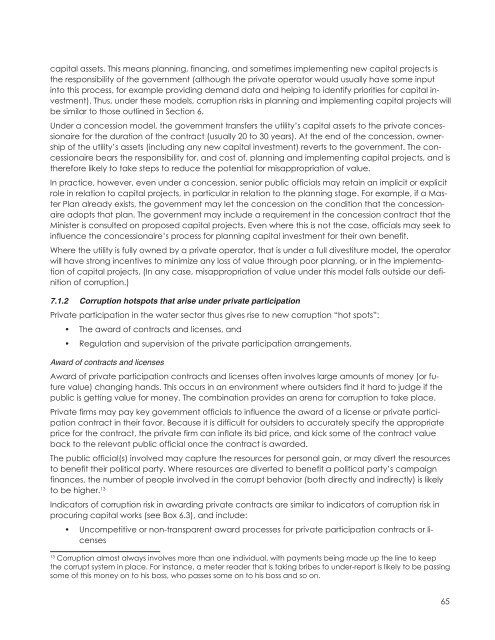A Sourcebook - UN-Water
A Sourcebook - UN-Water
A Sourcebook - UN-Water
You also want an ePaper? Increase the reach of your titles
YUMPU automatically turns print PDFs into web optimized ePapers that Google loves.
capital assets. This means planning, financing, and sometimes implementing new capital projects is<br />
the responsibility of the government (although the private operator would usually have some input<br />
into this process, for example providing demand data and helping to identify priorities for capital investment).<br />
Thus, under these models, corruption risks in planning and implementing capital projects will<br />
be similar to those outlined in Section 6.<br />
Under a concession model, the government transfers the utility’s capital assets to the private concessionaire<br />
for the duration of the contract (usually 20 to 30 years). At the end of the concession, ownership<br />
of the utility’s assets (including any new capital investment) reverts to the government. The concessionaire<br />
bears the responsibility for, and cost of, planning and implementing capital projects, and is<br />
therefore likely to take steps to reduce the potential for misappropriation of value.<br />
In practice, however, even under a concession, senior public officials may retain an implicit or explicit<br />
role in relation to capital projects, in particular in relation to the planning stage. For example, if a Master<br />
Plan already exists, the government may let the concession on the condition that the concessionaire<br />
adopts that plan. The government may include a requirement in the concession contract that the<br />
Minister is consulted on proposed capital projects. Even where this is not the case, officials may seek to<br />
influence the concessionaire’s process for planning capital investment for their own benefit.<br />
Where the utility is fully owned by a private operator, that is under a full divestiture model, the operator<br />
will have strong incentives to minimize any loss of value through poor planning, or in the implementation<br />
of capital projects. (In any case, misappropriation of value under this model falls outside our definition<br />
of corruption.)<br />
7.1.2 Corruption hotspots that arise under private participation<br />
Private participation in the water sector thus gives rise to new corruption “hot spots”:<br />
• The award of contracts and licenses, and<br />
• Regulation and supervision of the private participation arrangements.<br />
Award of contracts and licenses<br />
Award of private participation contracts and licenses often involves large amounts of money (or future<br />
value) changing hands. This occurs in an environment where outsiders find it hard to judge if the<br />
public is getting value for money. The combination provides an arena for corruption to take place.<br />
Private firms may pay key government officials to influence the award of a license or private participation<br />
contract in their favor. Because it is difficult for outsiders to accurately specify the appropriate<br />
price for the contract, the private firm can inflate its bid price, and kick some of the contract value<br />
back to the relevant public official once the contract is awarded.<br />
The public official(s) involved may capture the resources for personal gain, or may divert the resources<br />
to benefit their political party. Where resources are diverted to benefit a political party’s campaign<br />
finances, the number of people involved in the corrupt behavior (both directly and indirectly) is likely<br />
to be higher. 13<br />
Indicators of corruption risk in awarding private contracts are similar to indicators of corruption risk in<br />
procuring capital works (see Box 6.3), and include:<br />
• Uncompetitive or non-transparent award processes for private participation contracts or licenses<br />
13<br />
Corruption almost always involves more than one individual, with payments being made up the line to keep<br />
the corrupt system in place. For instance, a meter reader that is taking bribes to under-report is likely to be passing<br />
some of this money on to his boss, who passes some on to his boss and so on.<br />
65
















